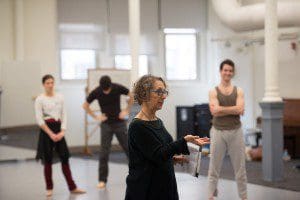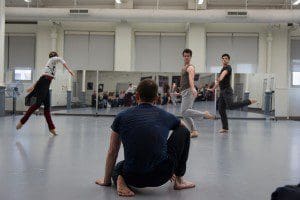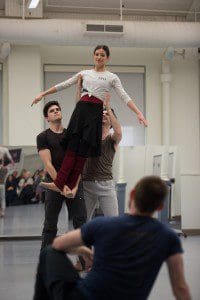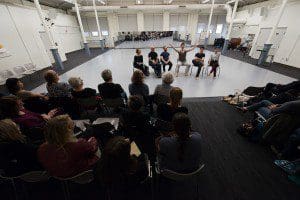Getting to the Nuts and Bolts of Trisha Brown
On April 29, Trisha Brown’s dance legacy was represented by three generations of her dancers in a rehearsal studio on the top floor of the Main Building at Drexel University for In the New Body: Nuts and Bolts. Facilitated by Lisa Kraus, the project director of Trisha Brown: In the New Body (a yearlong festival of Trisha Brown’s work) and a former Trisha Brown Dance Company (TBDC) dancer, Nuts and Bolts was an open rehearsal and discussion for audiences to observe a Pennsylvania Ballet company rehearsal for O zlozony / O composite, the Trisha Brown dance that will be part of the Pennsylvania Ballet’s “Balanchine and Beyond” program (June 9–12, tickets) at the Merriam Theater.
The Rehearsal
The floor was occupied by three Pennsylvania Ballet dancers—Ian Hussey (principal), Lillian de Piazza (soloist), and Aaron Anker (apprentice)—along with Neal Beasley, the youngest of the present TBDC legacy, who is setting Brown’s work on the dancers. The four of them were chatting, warming up, stretching, and reviewing the movement phrases they were about to share.
Stephen Petronio, TBDC’s first male dancer, sat in the front row, and he was hard to miss. He’s very tall with a shiny bald head, black thick-rimmed glasses, and a stately gray tuft of hair hanging from his chin. He possessed the air of being very important—many people were trying to talk to him at all once before the rehearsal started.
Those familiar with Trisha Brown and her work know that her creative process as well as her work is far from conventional—and this was manifest as soon as Beasley counted the beat using the alphabet instead of numbers. After one or two cycles of the alphabet, Beasley revealed that using the alphabet instead of a dancer’s go-to counts of six or eight was a tradition that Brown’s dancers started.
Each movement was deliberate, and monotonous in its rhythm dynamic, evenly fitting the steady timing of the alphabet, with each position or transition filling up one count (or letter). The vocabulary he used while he practiced the phrases with the dancers was colorful and rhythmic—almost poetic.
Beasley’s directing style was less critical instruction and served more as a reminder for the dancers of the origin and intent of the movement for unification, as well as to capture Brown’s original intent.
The Video Archive
When Brown’s aesthetic is ever in question, Beasley and the dancers refer back to Brown’s video archives. In following the experimental philosophy of the Judson Church Movement, Brown believed art was created in the process, which inspired her to catalogue her creative processes on video, which is now a treasured source for dancers who study and perform her work.
Beasley explained to the audience that he often uses the videos as a teaching tool in rehearsal. Beasley and the dancers then demonstrated a section of the dance when Lillian is lifted under her arms by Ian and Aaron where one leg stretched out behind her with the other one bent under her—and employed the video (which the audience could not see) when the lift wasn’t feeling or looking right. They tried the lift again with what Beasley called the “helicopter energy” they saw in the video. After two or three attempts, the lift looked completely effortless and significantly less awkward. The dancers achieved the desired helicopter energy, suspending Lillian through the air as if she were a feather.
Continuing the Legacy
Beasley came to Philadelphia to set this dance on the Pennsylvania Ballet. Throughout the rehearsal and into the discussion, Beasley shared memories and experiences of working under Brown, all of which expressed fondness and admiration. He spoke of the way Brown held a rehearsal, what was fascinating to her artistically and aesthetically, and how happy accidents, inside jokes, and her “infectious sense of humor” often influenced her choreography to take a different direction.
In creating O zlozony / O composite, Brown wanted to investigate where classical ballet and modern dance interact or intersect, and the discussion took a turn onto a path to the answer. Petronio summed up this investigation by mentioning the intersection and crossovers of the “languages and syntaxes” used in ballet and modern. For a ballet dancer, such as the three sitting next to him, he argued that certain movements might be similar to those in their ballet movement vocabulary and training, but is described or taught with a different vocabulary in the context of learning a modern work. Somehow, Trisha kept the gracefulness of ballet while staying true to what Neal described as her “idiosyncratic body,” which follows the unconventional and individualistic philosophy of the Judson Church Movement. The angular positions of the dance became especially sharp due to the ballet dancer’s emphasis on precision, the spatial patterns demanding the watcher’s attention with alternating unison, the dancers all flowing together as if they were one moving body.
Having never studied classical ballet, Brown was curious to enter the world of ballet after decades of post-modern exploration, and was fascinated in finding where the two vastly different practices intersect. O zlozony / O composite is Brown’s only “ballet,” and the only dance she created on a ballet company. She originally set O zlozony / O composite on three famous Paris Opera Ballet dancers, and with Pennsylvania Ballet, this marks the first time that her work is set on the dancers of an American ballet company.
The Discussion: Dancers and the Dance
The open rehearsal—for which the audience was asked to be “flies on the wall”—became an open dialogue among the Pennsylvania Ballet dancers and the Trisha Brown dancers. The three Pennsylvania Ballet dancers shared their thoughts about dancing O zlozony / O composite, particularly the specific differences in the aesthetics and practices between modern dance and classical ballet. For principal dancer Ian Hussey, the difference in the experience of dancing modern versus the experience in dancing ballet comes from the distinction of energies and intentions of the movement. In ballet and modern, he says, a dancer could achieve the same position, but the intent, or the pathway will be vastly different, and demonstrated an example using his arm. Similarly, soloist Lillian said that the transitions between positions hold the power to change a dance. “Transitions are what makes a dance interesting,” she said. Contrary to ballet, Lillian thinks of the physical feeling of “giving into gravity” when she dances O zlozony / O composite. To her, how a dancer defines their relationship to gravity is what ultimately defines a genre of dance.
In the course of this conversation, the term “natural occurrence” was thrown around when describing Brown’s choreography. “Natural occurrence” is often used when talking about modern dance because historically, modern dance was the product of the rebellion against classical ballet, which is often connoted as being unnatural or forced. Ian says his biggest challenge is finding that natural occurrence in his movement, or “letting the body take [him] through the choreography.” In practicing modern dance, Beasley added, comes the practice of “trusting that efficiency can equal fullness,” a skill that can be applied across all dance disciplines. Admitting that he was not always an efficient mover, Stephen said he used to be a very “muscular dancer” meaning that he clenched his muscles which exerted a less-than-efficient amount of energy. Trisha worked with Stephen to release the extra tension he was holding in his dancing, which changed his dancing life forever. He described how he created the mental image of himself as “bones in space,” an image that helped him feel himself moving from his skeleton outwards instead of from his musculature, freeing him from the tension he had been holding for so long.
See it in action!
Set to Polish poems and a musical score by Laurie Anderson, Trisha Brown’s O zlozony / O composite will be performed alongside George Balanchine’s The Four Temperaments and Hans Van Manen’s Adagio Hammerklavier. If you want a show that features a truly diverse and eclectic mix of genres performed by exceptional dancers, Pennsylvania Ballet’s “Balanchine and Beyond” will be playing at the Merriam Theater June 9–12.
Balanchine and Beyond
Pennsylvania Ballet
June 9-12
Merriam Theater
250 South Broad St
Philadelphia, PA 19102
–Julia Lendy





